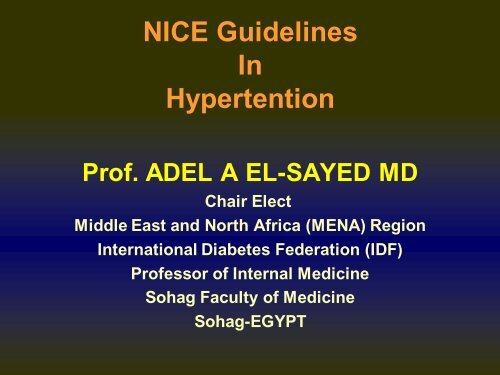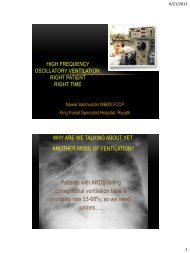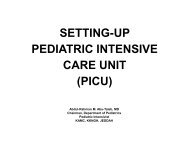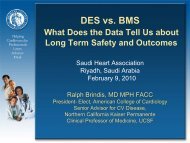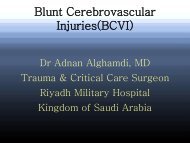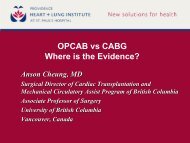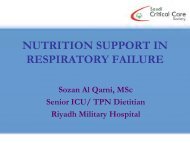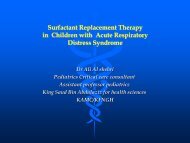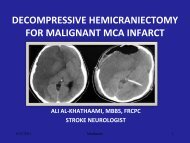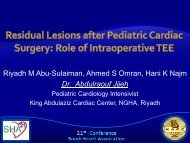NICE Guidelines In Hypertention - RM Solutions
NICE Guidelines In Hypertention - RM Solutions
NICE Guidelines In Hypertention - RM Solutions
You also want an ePaper? Increase the reach of your titles
YUMPU automatically turns print PDFs into web optimized ePapers that Google loves.
<strong>NICE</strong> <strong>Guidelines</strong><br />
<strong>In</strong><br />
<strong>Hypertention</strong><br />
Prof. ADEL A EL-SAYED MD<br />
Chair Elect<br />
Middle East and North Africa (MENA) Region<br />
<strong>In</strong>ternational Diabetes Federation (IDF)<br />
Professor of <strong>In</strong>ternal Medicine<br />
Sohag Faculty of Medicine<br />
Sohag-EGYPT
<strong>NICE</strong><br />
• The National <strong>In</strong>stitute for Health and Clinical<br />
Excellence (<strong>NICE</strong>) was set up in 1999 to reduce<br />
variation in the availability and quality of NHS<br />
treatments and care in England and Wales.<br />
• Every piece of <strong>NICE</strong> guidance and every <strong>NICE</strong><br />
quality standard is developed by an<br />
independent committee of experts including<br />
clinicians, patients, carers and health<br />
economists.
<strong>NICE</strong> <strong>Guidelines</strong><br />
• All of <strong>NICE</strong> guidance is considered and<br />
approved by the <strong>NICE</strong> Guidance Executive, a<br />
committee made up of <strong>NICE</strong> executive<br />
directors, guidance centre directors and the<br />
communications director, prior to publication.<br />
• Citizens Council, comprising 30 members of<br />
the public, provides <strong>NICE</strong> with advice that<br />
reflects the public's perspective on social and<br />
moral issues raised by the guidance.
<strong>NICE</strong> <strong>Guidelines</strong><br />
• <strong>NICE</strong> clinical guidelines are recommendations<br />
about the treatment and care of people with<br />
specific diseases and conditions in the NHS in<br />
England and Wales.<br />
• Healthcare professionals are expected to take<br />
it fully into account when exercising their<br />
clinical judgement.
<strong>NICE</strong> <strong>Guidelines</strong><br />
• However, the guidance does not override the<br />
individual responsibility of healthcare<br />
professionals to make decisions appropriate to<br />
the circumstances of the individual patient<br />
• This should be done in consultation with the<br />
patient and/or guardian or carer, after being<br />
informed by the summary of product<br />
characteristics of any drugs they are<br />
considering.
Understanding <strong>NICE</strong> guidance<br />
• A summary for patients and carers (‘Understanding<br />
<strong>NICE</strong> guidance’) is available from<br />
www.nice.org.uk/guidance/CG127/Public<strong>In</strong>fo<br />
• For printed copies, phone <strong>NICE</strong> publications on 0845<br />
003 7783 or email publications@nice.org.uk (quote<br />
reference number N2637).<br />
• <strong>NICE</strong> encourages NHS and voluntary sector<br />
organisations to use text from this booklet in their own<br />
information about primary hypertension.<br />
• Hypertension guidelines.
HTN <strong>NICE</strong> <strong>Guidelines</strong> Summary<br />
Contents<br />
• <strong>In</strong>troduction 5<br />
• Person-centred care 6<br />
• Key priorities for implementation 7<br />
• 1 Guidance 10<br />
• 1.1 Measuring blood pressure 10<br />
• 1.2 Diagnosing hypertension 11<br />
• 1.3 Assessing cardiovascular risk and target organ damage 14<br />
• 1.4 Lifestyle interventions 15<br />
• 1.5 <strong>In</strong>itiating and monitoring antihypertensive drug treatment, including blood pressure targets 16<br />
• 1.6 Choosing antihypertensive drug treatment 17<br />
• 1.7 Patient education and adherence to treatment 20<br />
• 2 Notes on the scope of the guidance 21<br />
• 3 Implementation 22<br />
• 4 Research recommendations 23<br />
• 4.1 Out-of-office monitoring 23<br />
• 4.2 <strong>In</strong>tervention thresholds for people aged under 40 with hypertension 23<br />
• 4.3 Methods of assessing lifetime CV risk in people aged under 40 years with hypertension 24<br />
• 4.4 Optimal systolic blood pressure 24<br />
• 4.5 Step 4 antihypertensive treatment 25<br />
• 4.6 Automated blood pressure monitoring in people with atrial fibrillation 25<br />
• 5 Other versions of this guideline 25<br />
• 6 Related <strong>NICE</strong> guidance 26<br />
• 7 Updating the guideline 27<br />
• Appendix A: The Guideline Development Groups, National Collaborating Centres and <strong>NICE</strong> project team 28<br />
• Appendix B: The Guideline Review Panels 33<br />
• Appendix C: The algorithms 35
Choosing antihypertensive drug treatment<br />
• Where possible, recommend treatment with<br />
drugs taken only once a day. [2004]<br />
• Prescribe non-proprietary drugs where these are<br />
appropriate to minimise cost. [2004]<br />
• Offer people with isolated systolic hypertension<br />
(systolic blood pressure 160 mmHg or more) the<br />
same treatment as people with both raised<br />
systolic and diastolic blood pressure. [2004]<br />
• Offer people aged 80 years and over the same<br />
antihypertensive drug treatment as people aged<br />
55–80 years, taking into account any<br />
comorbidities. [new 2011]
Choosing antihypertensive drug treatment<br />
Step 1 treatment<br />
• Offer people aged less than 55 years an angiotensinconverting<br />
enzyme (ACE) inhibitor or a low-cost angiotensin-II<br />
receptor blocker (ARB), if the ACE inhibitor is not tolerated<br />
(for example, because of cough). [new 2011]<br />
• Do not combine an ACE inhibitor with an ARB to treat<br />
hypertension. [new 2011]<br />
• Offer treatment with a calcium-channel blocker (CCB) to<br />
people aged over 55 years and to black people of African or<br />
Caribbean family origin of any age. If a CCB is not suitable, for<br />
example because of oedema or intolerance, or if there is<br />
evidence of heart failure or a high risk of heart failure, offer a<br />
thiazide-like diuretic. [new 2011]
Choosing antihypertensive drug treatment<br />
Step 1 treatment<br />
• If diuretic treatment is to be initiated or changed,<br />
offer a thiazide-like diuretic, such as chlortalidone<br />
(12.5–25.0 mg once daily) or indapamide (1.5 mg<br />
modified-release once daily or 2.5 mg once daily) in<br />
preference to a conventional thiazide diuretic such as<br />
hydrochlorothiazide. [new 2011]<br />
• For people who are already having treatment with<br />
hydrochlorothiazide and whose blood pressure is<br />
stable and well controlled, continue treatment with<br />
the hydrochlorothiazide. [new 2011]
Choosing antihypertensive drug treatment<br />
Step 1 treatment<br />
• Beta-blockers are not a preferred initial therapy for<br />
hypertension. However, beta-blockers may be<br />
considered in younger people, particularly:<br />
- those with an intolerance or contraindication to ACE<br />
inhibitors and angiotensin II receptor antagonists or<br />
- women of child-bearing potential or<br />
- people with evidence of increased sympathetic drive.<br />
[2006]<br />
• If therapy is initiated with a beta-blocker and a second<br />
drug is required, add a calcium-channel blocker rather<br />
than a thiazide-like diuretic to reduce the person’s risk<br />
of developing diabetes. [2006]
Choosing antihypertensive drug treatment<br />
Step 2 treatment<br />
• If blood pressure is not controlled by step 1 treatment,<br />
offer step 2 treatment with a CCB in combination with<br />
either an ACE inhibitor or an ARB (low cost). [new<br />
2011]<br />
• If a CCB is not suitable for step 2 treatment, for<br />
example because of oedema or intolerance, or if there<br />
is evidence of heart failure or a high risk of heart<br />
failure, offer a thiazide-like diuretic. [new 2011]<br />
• For black people of African or Caribbean family origin,<br />
consider an ARB in preference to an ACE inhibitor, in<br />
combination with a CCB. [new 2011]
Choosing antihypertensive drug treatment<br />
Step 3 treatment<br />
• Before considering step 3 treatment, review<br />
medication to ensure step 2 treatment is at<br />
optimal or best tolerated doses. [new 2011]<br />
• If treatment with three drugs is required, the<br />
combination of ACE inhibitor or angiotensin II<br />
receptor blocker, calcium-channel blocker and<br />
thiazide-like diuretic should be used. [2006]
Choosing antihypertensive drug treatment<br />
Step 4 treatment<br />
• Regard clinic blood pressure that remains higher than<br />
140/90 mmHg after treatment with the optimal or best tolerated<br />
doses of an ACE inhibitor or an ARB plus a CCB plus a diuretic as<br />
resistant hypertension, and consider adding a fourth<br />
antihypertensive drug and/or seeking expert advice. [new 2011]<br />
• For treatment of resistant hypertension at step 4:<br />
- Consider further diuretic therapy with low-dose spironolactone<br />
(25 mg once daily) if the blood potassium level is 4.5 mmol/l or<br />
lower. Use particular caution in people with a reduced estimated<br />
glomerular filtration rate because they have an increased risk of<br />
hyperkalaemia.<br />
- Consider higher-dose thiazide-like diuretic treatment if the blood<br />
potassium level is higher than 4.5 mmol/l. [new 2011]<br />
- At the time of publication (August 2011), spironolactone did not<br />
have UK marketing authorisation for this indication. <strong>In</strong>formed<br />
consent should be obtained and documented.
Choosing antihypertensive drug treatment<br />
Step 4 treatment<br />
• When using further diuretic therapy for resistant<br />
hypertension at step 4, monitor blood sodium<br />
and potassium and renal function within 1 month<br />
and repeat as required thereafter. [new 2011]<br />
• If further diuretic therapy for resistant<br />
hypertension at step 4 is not tolerated, or is<br />
contraindicated or ineffective, consider an alphaor<br />
beta-blocker. [new 2011]<br />
• If blood pressure remains uncontrolled with the<br />
optimal or maximum tolerated doses of four<br />
drugs, seek expert advice if it has not yet been<br />
obtained. [new 2011]
Research Recommendations<br />
• <strong>In</strong> adults with primary hypertension, does the use of out-ofoffice<br />
monitoring (HBPM or ABPM) improve response to<br />
treatment (in terms of clinical outcomes )<br />
• <strong>In</strong> people aged under 40 years with hypertension, what are<br />
the appropriate thresholds for intervention<br />
• <strong>In</strong> people aged under 40 years with hypertension, what is the<br />
most accurate method of assessing the lifetime risk of<br />
cardiovascular events (not the current short-term (10-year)<br />
risk estimates) and the impact of therapeutic intervention on<br />
this risk<br />
• <strong>In</strong> people with treated hypertension, what is the optimal<br />
systolic blood pressure (no large trials that have randomised<br />
people with hypertension to different systolic blood pressure<br />
targets )
Research recommendations<br />
• <strong>In</strong> adults with hypertension, which drug<br />
treatment (diuretic therapy versus other step<br />
4 treatments) is the most clinically and cost<br />
effective for step 4 antihypertensive<br />
treatment<br />
• Which automated blood pressure monitors<br />
are suitable for people with hypertension and<br />
atrial fibrillation
THANK YOU


